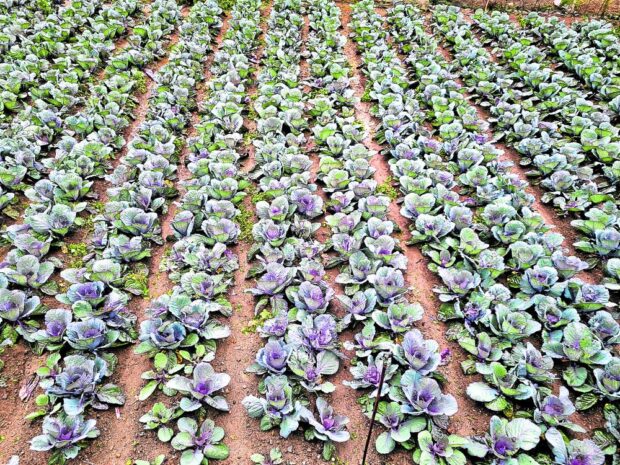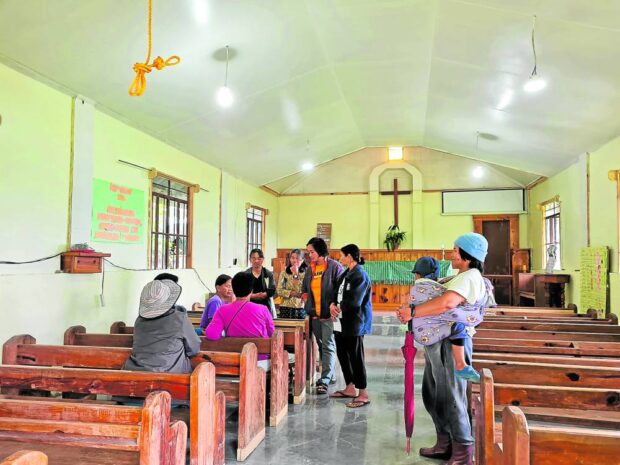Sagada farmers return to their roots

MAJESTIC VIEW | The town of Sagada in Mountain Province is famous for its tourist spots, rich culture, and terraced fields, which have been maintained and conserved by indigenous peoples clans for generations. (Photo by KRIXIA SUBINGSUBING / Philippine Daily Inquirer)
SAGADA, Mountain Province, Philippines — In Bangaan, a small village in this tourist town, vegetables and coffee grow among clouds.
It’s not uncommon, for example, to see homes that have not only backyards but also rooftop gardens lined with lettuce and chayote. Further up the mountains, hectares of coffee and fruit trees grow behind a cover of clouds that clear, however, on good days.
This is what has sustained the town generation after generation, said Danelia Toyoken, one of the farmers in Bangaan. Sagada is home to mostly Igorots, the collective term for indigenous peoples in the Cordillera which means “people from the mountains.”
But in recent years, a mercurial climate and a soil made acidic by commercial-grade pesticides have “made farming and gardening almost like gambling … What used to be a predictable science became unreliable,” Toyoken said.
She and other women of Bangaan “took it upon ourselves to return the richness of the mountain soil” by bringing back organic farming — without chemicals, without pesticides.
They are not alone. Across Sagada, women are increasingly at the forefront of efforts toward sustainable farming and environmental conservation.
‘Preserving our practices’

Among the cash crops planted this season is red lettuce, which will go to restaurants in the town. (Photo by KRIXIA SUBINGSUBING / Philippine Daily Inquirer)
By combining traditional farming knowledge with modern agricultural practices, the villagers help promote more sustainable methods to protect their crops and their mountains.
“As in most parts of the world, indigenous peoples, especially women, bear the responsibility of protecting the environment and preserving our practices,” said Gwendolyn Gaongen, a member of the council of elders on “batangan” (forest management) system.
“It is all the more important to empower and capacitate them [to] harness their contributions,” she said, adding that these efforts are rooted in the tribe’s “inviolable relationship” with the expanse of land — about 10,000 hectares of it — that is Sagada.
The town’s indigenous peoples farm however they could. Community broadcaster Domingo Manalog of Radyo Sagada said the farmers follow the mountain curve to carve out terraced fields or create community and home gardens.
‘Not for the markets’
Whatever form it took, farming is understood to be a communal activity among the tribe, said Martin Bacgalang, one of the elders of Sitio Bungalon. That means the farmer could till his neighbor’s land if his is too small, he said.
The men and women also have distinct yet flexible roles in the farming cycle. While men mostly do the manual work, the women are often in charge of preparing the land for sowing and banking seeds for the next planting, explained farmer Janet Tinangpap, 60.
Like other indigenous peoples groups, farmers of Sagada follow an agricultural calendar based on the lunar cycle, Bacgalang said.
About two decades ago, farmers would plant rice all year long in two six-month cycles. But eventually they learned to practice crop rotation during the rainy season to allow the soil to revive.
This was important because the people of Sagada, especially the women, “plant for the kitchen and not for the markets,” said Grael Bomowey, another farmer from Bangaan.
Crop rotation allowed them to cultivate lettuce, carrots, potatoes, chili peppers and Sagada beans, “which we could put on the table [and] only whatever is left over is sold. We don’t even eat vegetables that were grown outside (Sagada),” she said.
But the droughts became longer and the typhoons became stronger, said Salvador Kaduwagan, 65, who remembered that there were times when an entire harvest would be destroyed. This discouraged many farmers, who were forced to sell their plots, and started to work as tour guides or looked for other sources of income.

DISTINCT ROLES | Women farmers at Sitio Bungalon in Sagada discuss the harvest season and what they will do with their crops. (Photo by KRIXIA SUBINGSUBING / Philippine Daily Inquirer)
Sustainable agriculture
Others, like Safe Pekas, 47, sought ways to make their crops last longer. Years ago, when an earlier attempt to plant coffee under pine trees failed (because the soil was too acidic), she decided to study organic farming.
For advocates of sustainable agriculture, organic farming—which relies on composting to boost soil quality—not only reduces the use of chemicals but also significantly lowers carbon footprint and even sets apart more carbon from the soil.
Pekas said she learned to make her own compost with weeds, manure and kitchen waste. “It’s more laborious and expensive at first,” she said. After all, a 200-square-meter farm, relying on conventional farming methods, would need three tons of fertilizer worth P900 and organic compost which costs as much as P14,000 a ton.
However, these methods give the soil significantly more time to recover, allowing it to produce high-quality crops, Pekas said. She also planted buffer plants like bamboo and fruit trees to shield her vegetables from the impact of typhoons.
Now she uses her own vegetables — lettuce, cabbage, eggplant — as ingredients for her restaurant, “Salt & Pepper,” a staple in Sagada’s food scene. She also opened a training school named after her restaurant, which offers a 29-day course on organic farming, hog raising and compost making. The school is accredited by the Technical Education and Skills Development Authority.

ORGANIZED | For three years, an all-women farmers’ association in the village of Bangaan in Sagada has taken on the challenge of reviving indigenous farming methods through organic farming. They have been offering training to schools and fellow farmers to pass on the knowledge and help conserve nature. Among the cash crops that they planted this season is red lettuce, which will go to restaurants in the town. (Photo by KRIXIA SUBINGSUBING / Philippine Daily Inquirer)
Resilience
Pekas said about 200 farmers had availed themselves of her training program, including the women in Bangaan.
One of them is Benita Doga-ong, who in 2020 decided to enroll in Pekas’ school.
“Of course, we grew up on organic methods anyway,” she said. “But we saw the effect of commercial farming on our gardens and wanted to bring [organic farming] back as a norm.”
Bomowey said: “We also wanted to update our knowledge with more modern techniques. Of course, our ancestors developed this method because it was the most natural, but we also acknowledge how new ways could improve the resilience of our farms.”
Apart from compost making, farmers learned how to use trichoderma fungus as a biofertilizer, and biocontrol agents like beetles and wasps to stop weeds and pests from damaging their crops.
Some of the farmers, like Toyoken, Bomowey, and Doga-ong, began opening their farms to tourists—who noted with appreciation Doga-ong’s coffee trees and Toyoken’s vegetable farms up in the mountains, while also learning of the benefits of organic crops.
As more women in Bangaan enlist for training, they decided to organize themselves into an all-women farmers’ association, reasserting indigenous methods in agriculture.
Called BFTAMP, after the Sagada villages where they came from (Bangaan, Fidelisan, Tanulong, Aguid, Madongo and Pide), the association is also training other farmers to encourage organic methods.
“People tend to think traditional ways are outdated because they’re laborious and not as quick and as high-yield[ing] as commercial farming,” said Aubrey Cadalig Doyog, the group’s president. “But in the long run, this is what will preserve the land for the next generation.”
She agrees, however, that government and civil society could work together to promote indigenous ways.
The Department of Agriculture, for one, could help farmers jumpstart their transition to organic farming by providing financial aid and training, while academic institutions could help popularize organic farming methods through research and development.
“The most important thing is to ensure there is continuity of learning,” said Pekas. “That is how you see how it subtly transforms a community.”